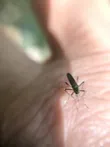Harmful Effects of Brown saltmarsh mosquito
A species of Mosquito
Brown saltmarsh mosquito bites can transmit diseases to humans, though the likelihood varies. Transmission occurs when females pierce skin to feed on blood, potentially causing irritation or allergic reactions. Some bites may require medical attention, but most are minor discomforts. No life-threatening risks from brown saltmarsh mosquito are indicated without disease presence.
Does the Brown saltmarsh mosquito bite humans or animals?
Harmful Facts About Brown saltmarsh mosquito
What Type of Pest Is Brown saltmarsh mosquito?









AI entomologist in your pocket
Scan QR code to download

